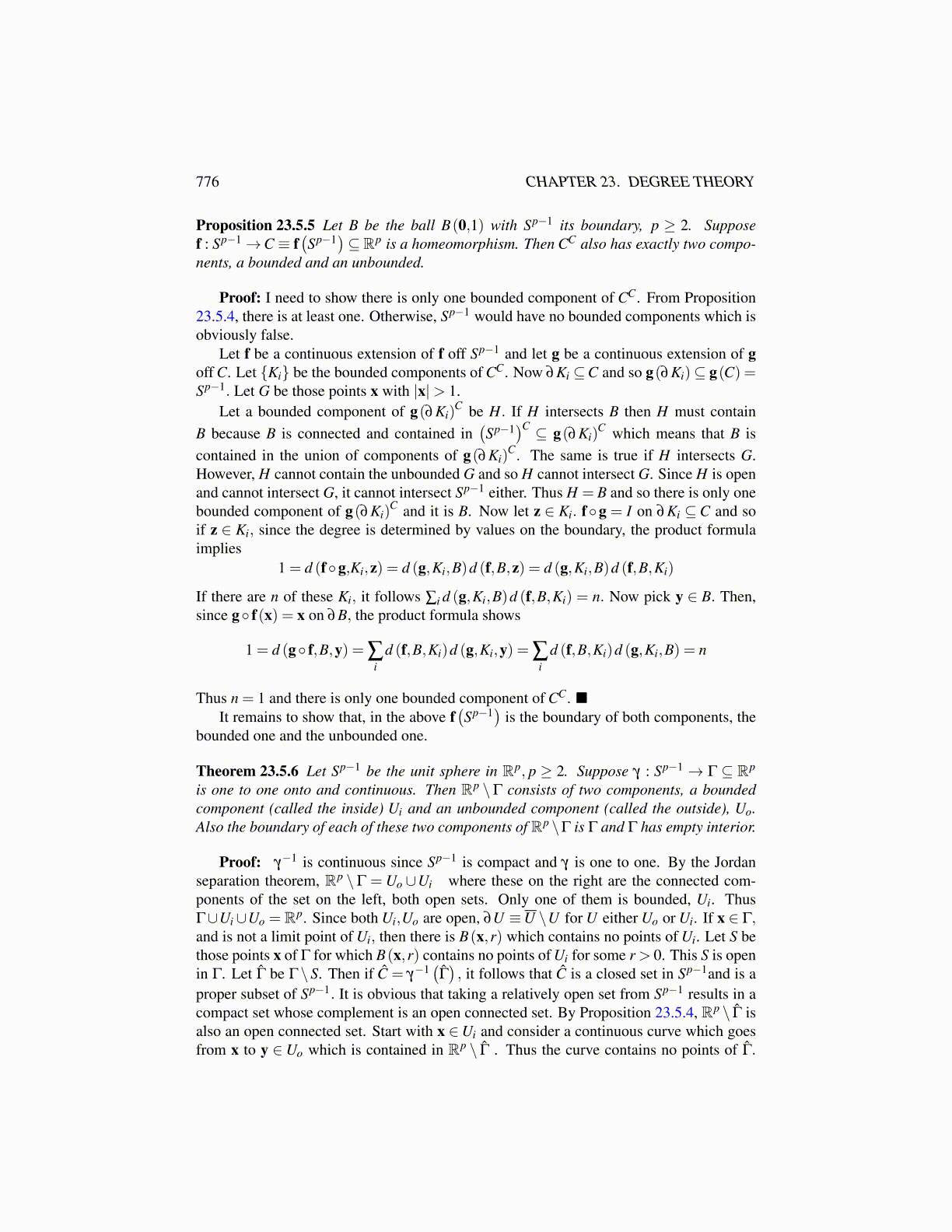
776 CHAPTER 23. DEGREE THEORY
Proposition 23.5.5 Let B be the ball B(0,1) with Sp−1 its boundary, p ≥ 2. Supposef : Sp−1→C ≡ f
(Sp−1
)⊆ Rp is a homeomorphism. Then CC also has exactly two compo-
nents, a bounded and an unbounded.
Proof: I need to show there is only one bounded component of CC. From Proposition23.5.4, there is at least one. Otherwise, Sp−1 would have no bounded components which isobviously false.
Let f be a continuous extension of f off Sp−1 and let g be a continuous extension of goff C. Let {Ki} be the bounded components of CC. Now ∂Ki ⊆C and so g(∂Ki)⊆ g(C) =Sp−1. Let G be those points x with |x|> 1.
Let a bounded component of g(∂Ki)C be H. If H intersects B then H must contain
B because B is connected and contained in(Sp−1
)C ⊆ g(∂Ki)C which means that B is
contained in the union of components of g(∂Ki)C. The same is true if H intersects G.
However, H cannot contain the unbounded G and so H cannot intersect G. Since H is openand cannot intersect G, it cannot intersect Sp−1 either. Thus H = B and so there is only onebounded component of g(∂Ki)
C and it is B. Now let z ∈ Ki. f◦g = I on ∂Ki ⊆ C and soif z ∈ Ki, since the degree is determined by values on the boundary, the product formulaimplies
1 = d (f◦g,Ki,z) = d (g,Ki,B)d (f,B,z) = d (g,Ki,B)d (f,B,Ki)
If there are n of these Ki, it follows ∑i d (g,Ki,B)d (f,B,Ki) = n. Now pick y ∈ B. Then,since g◦ f(x) = x on ∂B, the product formula shows
1 = d (g◦ f,B,y) = ∑i
d (f,B,Ki)d (g,Ki,y) = ∑i
d (f,B,Ki)d (g,Ki,B) = n
Thus n = 1 and there is only one bounded component of CC.It remains to show that, in the above f
(Sp−1
)is the boundary of both components, the
bounded one and the unbounded one.
Theorem 23.5.6 Let Sp−1 be the unit sphere in Rp, p ≥ 2. Suppose γ : Sp−1 → Γ ⊆ Rp
is one to one onto and continuous. Then Rp \Γ consists of two components, a boundedcomponent (called the inside) Ui and an unbounded component (called the outside), Uo.Also the boundary of each of these two components of Rp \Γ is Γ and Γ has empty interior.
Proof: γ−1 is continuous since Sp−1 is compact and γ is one to one. By the Jordanseparation theorem, Rp \Γ = Uo ∪Ui where these on the right are the connected com-ponents of the set on the left, both open sets. Only one of them is bounded, Ui. ThusΓ∪Ui∪Uo = Rp. Since both Ui,Uo are open, ∂U ≡U \U for U either Uo or Ui. If x ∈ Γ,and is not a limit point of Ui, then there is B(x,r) which contains no points of Ui. Let S bethose points x of Γ for which B(x,r) contains no points of Ui for some r > 0. This S is openin Γ. Let Γ̂ be Γ\S. Then if Ĉ = γ−1
(Γ̂), it follows that Ĉ is a closed set in Sp−1and is a
proper subset of Sp−1. It is obvious that taking a relatively open set from Sp−1 results in acompact set whose complement is an open connected set. By Proposition 23.5.4, Rp \ Γ̂ isalso an open connected set. Start with x ∈Ui and consider a continuous curve which goesfrom x to y ∈Uo which is contained in Rp \ Γ̂ . Thus the curve contains no points of Γ̂.